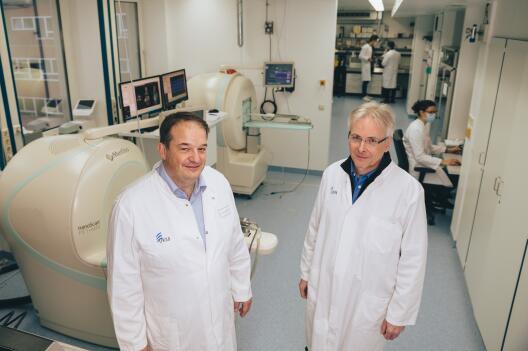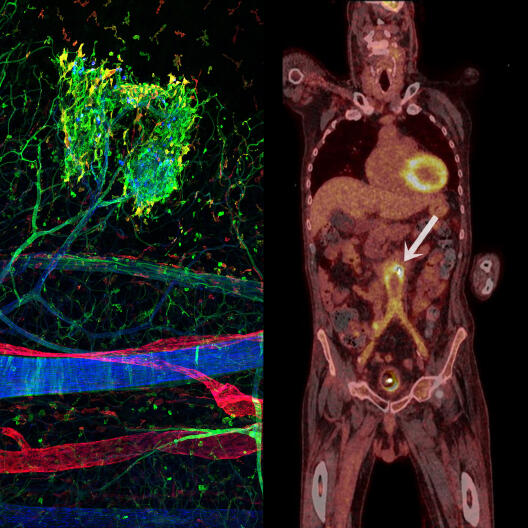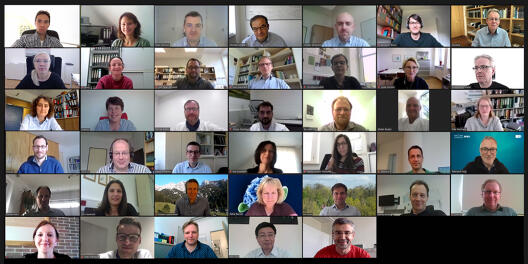Gaining insight into organ-specific inflammation through “multiscale imaging”

Whenever tissue is damaged in the body – e.g. through infarctions, autoimmune diseases and infections – inflammation occurs. It is the immune system’s instantanious reaction to external stimuli and acute dangers and, in principle, something positive: inflammation limits damage and promotes the healing process. But the body is not always able to bring the situation under control and inflammation can become life-threatening or chronic, permanently impairing the function of organs. A challenge medicine is facing, at present, is to predict how inflammation will progress. The German Research Foundation (DFG) is now providing funding for the new Collaborative Research Centre (CRC) “inSight – Multiscale imaging of organ-specific inflammation” at the University of Münster, which is aiming to help find a solution.
“We are aiming for a comprehensive understanding of how the body regulates inflammation in different organs and which cellular processes are decisive in determining whether an inflammation develops in a productive or destructive way,” explains Prof Michael Schäfers, nuclear medicine specialist and spokesperson of the new collaborative research project. In order to observe and analyse immune reactions on different scales, from the individual cell to the entire organism, and from mice to men, the researchers want to develop a specific “multiscale imaging” methodology which requires innovative strategies for the chemical-biological labelling of cells and the evaluation of image data using mathematical models and artificial intelligence. Funding of around ten million euros will start in January 2021 and the project will initially run for four years. Afterwards, the researchers can apply for up to two further funding periods of four years each. The project is part of the research focus “cell dynamics and imaging” at the University of Münster. In the future, a large number of participating scientists from the different faculties will be based together in the new Multiscale Imaging Centre at the University, which is currently being built.
Research objectives and clinical perspectives of the project in detail

The researchers want to analyse when and where different immune cells become active in the organism when inflammation occurs, via which molecular mechanisms they interact with each other and their environment, and which specific functions they have in the inflammation of different organs. In tackling these questions, they will incorporate different imaging technologies – both microscopic and whole-body methods – into their investigations and integrate information gathered from the individual cellular level up to the level of the entire organism. “We expect that this holistic view will allow us to identify links between cellular inflammation mechanisms and the function of organs,” says Michael Schäfers. This “multiscale imaging” requires new chemical-biological strategies to label the same cell type, or even the same cell, with different signal transmitters, e.g. with fluorescent, magnetic or radioactive molecules, because these generate signals that become visible through different imaging technologies. New challenges are also posed by the need to integrate data sets from different imaging techniques to recognise complex patterns in cell behaviour on a holistic level. Mathematical models and the training of artificial intelligence – so-called deep learning – play an essential role here. The importance of biomedical imaging in the research project is also incorporated in its name: the term “insight” reflects how things made visible using new methodologies – that are now “in sight” – provide researchers with new “insights”.
In the long term, the scientists expect their results to lead to new diagnostic approaches for clinical imaging modalities such as nuclear imaging, magnetic resonance imaging and photoacoustic imaging. Such methods could help detect inflammation associated with, for example, heart attacks, autoimmune diseases that lead to inflammation of the joints, skin or intestines, and bacterial infections in the lungs or kidneys. They could finally help to find and assess the efficacy of an immunoregulatory therapy that is tailored to individual patients.
Interdisciplinary cooperation and promotion of junior researchers within the project

In the new Collaborative Research Centre, clinician scientists, biochemists, chemists, physicists, mathematicians and computer scientists from more than 30 research groups are working together in various collaborations. The individual subprojects are, to varying degrees, dedicated to both developing imaging methods and/or using them to analyse inflammatory processes. It is anticipated that the investigations will lead to the generation of new biomedical hypotheses, the verification of which will likely pose new challenges necessitating further methodological development. This research concept requires a high level of interaction between the disciplines involved, which is why experts from the different disciplines will not only work together in the context of the entire network, but also within individual subprojects.
Since both clinical and scientific perspectives will contribute to advancing the research concept, the CRC begins promoting an interdisciplinary research culture early in the scientific career. “The doctoral period is the best time for intense interactions between the different disciplines,” explains Prof Friedemann Kiefer, biochemist and deputy spokesperson of the network, “once advanced in their career, physicians usually become immersed in patient care while natural scientists have little access to clinical and medical challenges”. In the Integrated Research Training Group “Multiscale Imaging”, doctoral students from both professions will participate in a combined training programme and undertake research at the intersection of medicine and the natural sciences. After the doctorate, the network supports interdisciplinary early career researchers on their way to scientific independence – postdocs can, for example, apply for funding to pursue new research ideas related to the scientific concept of the CRC, thus paving the way for project leadership during future funding periods.
Author: Doris Niederhoff
Thanks to Julie Davies for a critical review.

